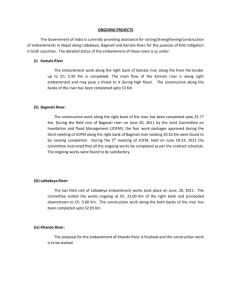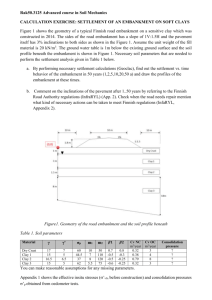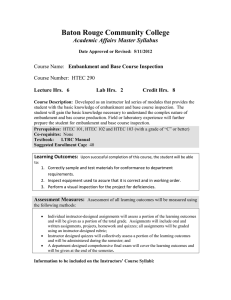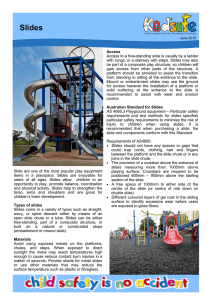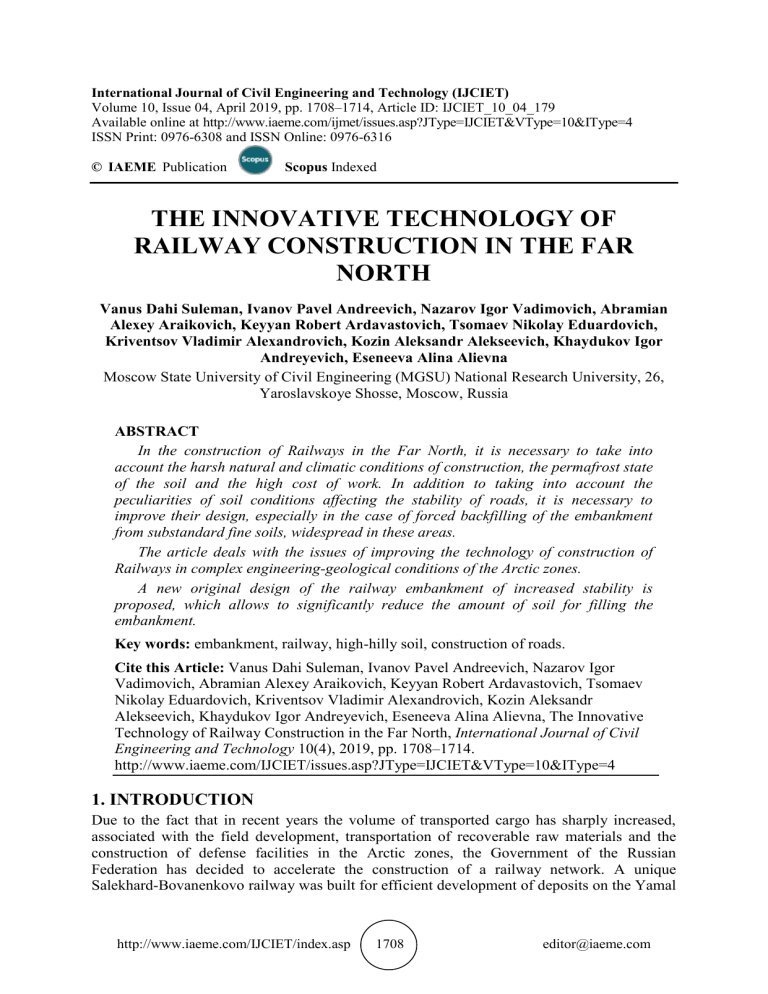
International Journal of Civil Engineering and Technology (IJCIET) Volume 10, Issue 04, April 2019, pp. 1708–1714, Article ID: IJCIET_10_04_179 Available online at http://www.iaeme.com/ijmet/issues.asp?JType=IJCIET&VType=10&IType=4 ISSN Print: 0976-6308 and ISSN Online: 0976-6316 © IAEME Publication Scopus Indexed THE INNOVATIVE TECHNOLOGY OF RAILWAY CONSTRUCTION IN THE FAR NORTH Vanus Dahi Suleman, Ivanov Pavel Andreevich, Nazarov Igor Vadimovich, Abramian Alexey Araikovich, Keyyan Robert Ardavastovich, Tsomaev Nikolay Eduardovich, Kriventsov Vladimir Alexandrovich, Kozin Aleksandr Alekseevich, Khaydukov Igor Andreyevich, Eseneeva Alina Alievna Moscow State University of Civil Engineering (MGSU) National Research University, 26, Yaroslavskoye Shosse, Moscow, Russia ABSTRACT In the construction of Railways in the Far North, it is necessary to take into account the harsh natural and climatic conditions of construction, the permafrost state of the soil and the high cost of work. In addition to taking into account the peculiarities of soil conditions affecting the stability of roads, it is necessary to improve their design, especially in the case of forced backfilling of the embankment from substandard fine soils, widespread in these areas. The article deals with the issues of improving the technology of construction of Railways in complex engineering-geological conditions of the Arctic zones. A new original design of the railway embankment of increased stability is proposed, which allows to significantly reduce the amount of soil for filling the embankment. Key words: embankment, railway, high-hilly soil, construction of roads. Cite this Article: Vanus Dahi Suleman, Ivanov Pavel Andreevich, Nazarov Igor Vadimovich, Abramian Alexey Araikovich, Keyyan Robert Ardavastovich, Tsomaev Nikolay Eduardovich, Kriventsov Vladimir Alexandrovich, Kozin Aleksandr Alekseevich, Khaydukov Igor Andreyevich, Eseneeva Alina Alievna, The Innovative Technology of Railway Construction in the Far North, International Journal of Civil Engineering and Technology 10(4), 2019, pp. 1708–1714. http://www.iaeme.com/IJCIET/issues.asp?JType=IJCIET&VType=10&IType=4 1. INTRODUCTION Due to the fact that in recent years the volume of transported cargo has sharply increased, associated with the field development, transportation of recoverable raw materials and the construction of defense facilities in the Arctic zones, the Government of the Russian Federation has decided to accelerate the construction of a railway network. A unique Salekhard-Bovanenkovo railway was built for efficient development of deposits on the Yamal http://www.iaeme.com/IJCIET/index.asp 1708 editor@iaeme.com The Innovative Technology of Railway Construction in the Far North Peninsula and work was started on the construction of another unique railway as a part of the Northern Latitudinal Railway project, which is planned to be completed by 2023. It is assumed that this new highway will give impetus to the economic development of the Polar region, relieve the Trans-Siberian Railway and increase the flow of goods along the Northern Sea Route. However, it is necessary to take into account the high cost of laying railway tracks. 2. STUDY OF RAILWAY TRANSPORT According to the Institute of the Study of Railway Transport Problems, the cost of building of 1 km of a new railroad could cost $ 2.8 million! Efficient development of unique oil and gas fields, as well as accelerated development of defense facilities in the Arctic zones, require more rapid development of the transport network. However, the harsh climatic conditions, the widespread distribution of structurally unstable when thawing permafrost finely dispersed soils, the lack of a sufficient number of certified soil materials necessary for the construction of roads restrain the large-scale development of the Arctic territories. It is well known that the effective development of unique and strategically important fields for our country, as well as their reliable protection, is impossible without the use of new technological and constructive solutions for the construction of facilities in difficult remote areas of the Far North [1]. In addition to the harsh climatic conditions, the Arctic territories are characterized by a wide distribution of highly icy and especially finely dispersed soils, which are the most difficult and dangerous from the point of view of construction. Such soils in the process of thawing transfer into a structurally unstable state. Road embankments and platforms filled with such soils are subject to strong destructive processes leading to their destruction [2]. There are three main methods of increasing the stability of the earth embankments, slept on frozen soils: preservation of the base and the embankment itself in the frozen state; the use of special constructive solutions embankment; modification is structural hardening of the soil dumping embankment [3]. This research is devoted to solving the important issue of increasing the stability of a dirt embankment filled from substandard fine-dispersed high-icy soils by preserving the base and embankment in a frozen state using a new embankment design, which makes it possible to reduce the amount of soil filled significantly. Known technical solution is a method of temperature stabilization of the foundation of structures on permafrost soils by using a cooling system in the form of pipes laid under a layer of thermal insulation over the entire area of the base located in the railroad bedrock, organizing artificial soil freezing and maintaining it in a frozen state [4] The disadvantage of this technical solution is the high cost of its implementation, as well as low cooling efficiency due to the complexity of covering the entire volume of the embankment and, as a consequence, the creation of conditions for the development of uneven sediment embankment, which leads to a decrease in the stability of the embankment, and in general it reduces the efficiency of the method. Considering the importance of solving the problem of increasing the efficiency of transport construction in the Arctic zones, a new original construction of the railway embankment of enhanced stability was offered (Pic. 1) [5]. http://www.iaeme.com/IJCIET/index.asp 1709 editor@iaeme.com Vanus Dahi Suleman, Ivanov Pavel Andreevich, Nazarov Igor Vadimovich, Abramian Alexey Araikovich, Keyyan Robert Ardavastovich, Tsomaev Nikolay Eduardovich, Kriventsov Vladimir Alexandrovich, Kozin Aleksandr Alekseevich, Khaydukov Igor Andreyevich, Eseneeva Alina Alievna If the offered construction is implemented, the technical effect will be obtained by increasing the stability of the embankment, reducing the volume of soil dumping with associated utilization of used rail tank cars. Figure 1 Cross-section of the embankment with the location of rail tankers on a frozen base: 1 embankment; 2 - frozen base; 3 - used tanks; 4 - rope; 5 - geogrid (geofoot); 6 – ballast The problem is solved by installing a volumetric cooling system in the embankment from spent railway tanks (from gasoline, oil, etc.). Firstly such a construction of the embankment makes it possible to dispose the used tanks profitably, secondly, due to the rigidity of tanks, to save on the volume of dumping of the embankment, especially for those regions where there is a lack of certified soils, thirdly, the overall volumetric deformations of the embankment soil are reduced, thereby increasing its stability and, fourthly, performing the function of a cold accumulator due to its large volume, the halo of soil cooling around the tank increases significantly, keeping it longer, which increases efficiency use of the cooling system as a whole. At the same time, the efficiency of tank freezing can be increased by installing radiator fins on them. It should be noted that the operation of the cooling system can be automated by installing temperature sensors and a control computer, which further will increase the efficiency of its operation. Installing transverse tanks in the intervals between longitudinal tanks will allow to distribute the temperature field more evenly, especially in places where the embankment is turning (Pic. 3). Laying railroad cisterns in two lines can significantly reduce the amount of soil to be dumped, reduce volumetric soil deformations, increase the embankment-freezing zone and generally improve the stability of the embankment, especially when laying roads on particularly dangerous from the point of view of geocryological (soil) construction conditions. As a model of the work of the tank in the embankment can be used the scheme of the culverts, laid in the embankments of roads. It should be borne in mind that in the northern regions of the country there is small amount of top sands, gravel and gravelly-pebbly soils, which, with appropriate compaction of 0.95–0.98 standard density, could ensure reliable operation of the embankment and the ―pipe-soil‖ system. Fine or wet dusty and watersaturated (high ice) sands with a small deformation modulus (E <20 kPa), which are practically unsuitable for backfilling and filling of embankments, are mostly common [6]. The practice of building roads in the difficult frozen conditions of the North and at BaikalAmur Mainline showed that many culverts are being deformed. The greatest deformations are manifested in the form of elongation — stretching and precipitation. As a rule, stretching is accompanied by an uneven draft of the pipe section. Constant monitoring of the condition of the pipes showed that the main deformations occurred during the filling of the embankment and the first year of operation. Thus, the http://www.iaeme.com/IJCIET/index.asp 1710 editor@iaeme.com The Innovative Technology of Railway Construction in the Far North elongation of separate pipes could have reached 50% of the total strain over a ten-year observation period [7]. Shielding elements in the form of flexible bands can be used for prevention. The shielding elements are designed to reduce friction forces along the outer surfaces [7]. For the calculation of the work of the tank - for one line or two tanks - for two lines in the embankment, the method of calculating metal corrugated pipes, widely used in the construction of roads in the North, can be applied [8; 9]. It is assumed that in the initial period of the layer-by-layer dumping of the embankment, the section of the pipe (tank) at the top takes the oval form 2. (Pic.2) As dumping is done, the tank is deformed inwards vertically and outwards horizontally. Lateral deformations (movements) of the tank cause a response reaction from the surrounding soil in the form of elastic resistance 4, which ensures the overall equilibrium of the ―tank-soil‖ system. We accept that from the side of the slopes the elastic repulse of the ground will be insignificant. The calculation method is based on the idea that the limiting state of a flexible pipe (tank) under load P can reach passive resistance of soil 4 at zero values 4. Figure 2 The design scheme of the operation of tanks of two threads in the embankment: 1 - the type of form of the tank before deformation; 2 - the same at the moment of maximum equilibrium; 3 - the same after the exhaustion of the carrying capacity; 4 - elastic resistance (passive pressure) This is explained by the fact that due to the growth of transverse deformations of the pipe (tank) directed inwards, the volume of the pipe begins to decrease and no further soil compaction occurs. The accepted condition makes it possible to determine the limiting values of the vertical load P and the vertical deformation of the pipe (tank). Firstly, the operation of the volumetric cooling system in the form of a rigid element from spent rail semi-tankers allows, to increase the contact area with the base and, accordingly, to increase the effectiveness of the cooling effect from the joint work of semi-tanks with the frozen base. Secondly, due to the increased reference area with the base and, accordingly, increased adhesion to the base soil, it increases the stability of the embankment, which generally improves the efficiency of their use. The depth of the tanks in the frozen base to a depth h equal to the depth of the natural thawing of the soil makes it possible to increase the coverage and influence on the base thawing area, thereby maintaining it more reliably in the frozen state (Pic. 4). The distance between the tanks b, equal to no more than two halo values of soil freezing around the tank end, is \ selected due to the condition of maintaining the steady state of the embankment. In case of assigning a distance between the tanks equal to more than two halo values, this will lead to the emergence of thawing zones, and if less than two halo values are http://www.iaeme.com/IJCIET/index.asp 1711 editor@iaeme.com Vanus Dahi Suleman, Ivanov Pavel Andreevich, Nazarov Igor Vadimovich, Abramian Alexey Araikovich, Keyyan Robert Ardavastovich, Tsomaev Nikolay Eduardovich, Kriventsov Vladimir Alexandrovich, Kozin Aleksandr Alekseevich, Khaydukov Igor Andreyevich, Eseneeva Alina Alievna assigned, an unnecessary consumption of refrigerant and an increase in the number of tanks will occur. The embankment of the railway on permafrost soils consists of the embankment 1 itself, poured onto the prepared foundation 2, on which, for example, used tanks 3 laid in two lines, performing the function of a volumetric cooling system and connected by pipelines 7 (see Fig. 1, Fig. 3 ). Used tanks are connected by transverse flexible connections - ropes 4 and have ventilation outlets 8 and radiator fins 9. In the upper part of the embankment 1 - at the base of the ballast prism 6, geogrid 5 is laid to increase the bearing capacity of the roadway. The proposed technology is implemented as follows. When working in winter, a cooling system is assembled on a cleared part of the road being built. For this, waste tanks 3 are laid in one or two threads, fixing them, for example, with wooden corners (see Pic. 1). In the case of filling a low embankment, the cooling system is collected from semi-tanks, which are not required to be fixed. Tanks are interconnected by pipelines 7 and with the feeder refrigerant. Then, embankment 1 is filled from high-rolled ground on frozen base 2, leaving the ventilation outlets 8 free in the embankment slopes of tanks installed across the road (Pic. 3). In order to increase the degree of compaction of the embankment soil, the operation of its warming up can be used to thaw the soil partially. In this case, short-term pumping of hot air through the threads from the tanks is recommended. Figure 3. A variant of the location of rail tank cars in the plan: 2 - frozen foundation; 3 - used tanks; 7 - pipelines; 8 - ventilation outlets; 9 - radiator fins After that, the ballast 6 is poured off and the rail track is laid. The ventilation outlets of 8 tanks in the slopes of the embankment, installed across the road route, are opened, and natural or forced ventilation with cold air is carried out through all the tanks, thereby maintaining the embankment in a frozen stable state. When working in the summer, one or two trenches are arranged on the cleared part of the road being built. depending on how many tank lines are designed, the soil is removed to the depth of its thawing h and a cooling system is arranged according to the operations performed and described above (Pic. 4) . In the warm season, the ventilation outlets of 8 tanks in the slopes of the embankment, installed across the road route, are closed, and the embankment is frozen by passing refrigerant through tank 3 (see Pic. 3). http://www.iaeme.com/IJCIET/index.asp 1712 editor@iaeme.com The Innovative Technology of Railway Construction in the Far North Figure 4. A transverse section of the embankment on a frozen foundation with the location of the railway tanks in the recessed state: 1 - embankment; 2 - frozen base; 3 - used tanks; 4 - rope; 5 geogrid; 6 - ballast Pumping the refrigerant through the tank system, the embankment and the base are cooled. At the same time, the efficiency of freezing of embankment 1 by tanks 3 is increased due to the installation of radiator fins 9 on them. Turning on the cooling system, they freeze the surrounding layers of soil around the tanks with the ability to maintain them in a given thermo-rheological state with the formation of a freezing halo around tanks that capture the entire volume of the embankment. In this case, the operation of the cooling system can be automated by installing temperature sensors and a control computer. We can draw the following conclusion. The preliminary performed exploration work has shown that the stability of a dirt embankment filled from substandard high fine, finely dispersed soils can be improved by changing its structure, which allows the embankment to be maintained in a stable state in case of its thawing. The use of waste tanks for this purpose as cold accumulators allows achieving structural thermal strengthening of a dirt embankment in its entire volume during periods of thawing. At the same time, the volume of dumped substandard soil is significantly reduced, along with efficient utilization of used tanks. The introduction of the offered technical solution will certainly ensure the stability of the railway in the summer and significantly reduce the material costs of its construction in the difficult conditions of the Far North. It is especially effective to use the offered technical solution in difficult construction sites in the Arctic zones, characterized by a wide distribution of structurally unstable high-ice soils and the lack of adequate soil materials used for the construction of road embankments. REFERENCES [1] Ataev S. S., Technology of building production: the Textbook for high schools / S. S. Ataev, N. N. Danilov, B. V. Prikin [and others]. – ], 2014.- 432 p. [2] Culverts in permafrost / A. S. Potapov, R. E. Povalny, E. F. Kaznacheeva, R. S. Kleiner // Transp. page. – 2018. – №1. [3] Interaction of corrugated pipes with soil in the process of filling / A. S. Potapov, E. F. Treasurer, Z. M. Palkina, M. G. Ratkevich // Transp. page. – №5. – 2018. – P.43-45. http://www.iaeme.com/IJCIET/index.asp 1713 editor@iaeme.com Vanus Dahi Suleman, Ivanov Pavel Andreevich, Nazarov Igor Vadimovich, Abramian Alexey Araikovich, Keyyan Robert Ardavastovich, Tsomaev Nikolay Eduardovich, Kriventsov Vladimir Alexandrovich, Kozin Aleksandr Alekseevich, Khaydukov Igor Andreyevich, Eseneeva Alina Alievna [4] Kondratyev V. G. Stabilization of the roadbed on permafrost soils: monograph. – Chita: Poligrafresurs, 2011. – 176 p. [5] 5. 0пыт construction of corrugated culverts / V. P. Chernyavskaya, S., Teitelman, P. D. Strelnikov [et al.] / / Transp. page. – №1. – 2017. – Pp. 8-11. [6] Patent RF № 2415226. IPC: Е02D 3/115. System for temperature stabilization of the base of structures on permafrost soils / G. M. Dolgikh [etc.]. – 2016. – 8 PP. [7] RF patent 2657310. IPC: E01C 3/06. Railway embankment on permafrost / V. I. Trofimov. Published: Byul. No. 17. – 2018. – 8 PP. [8] Construction of communication routes in the North / S. Ya. Lutsky, T. V. Shepitko, P. M. Tokarev, A. N. Dudnikov. – M.: LATMES, 2009. – 286 p. [9] Trofimov V. I. Improving the efficiency of transport construction in the Arctic zones. Scientific Bulletin of the Arctic. – 2018. – №3. – P. 31-39. [10] Trofimov V. I., Kondrat'ev, V. G. Geotechnology and construction of frozen organic and mineral soils]. – Tver: Tvstu, 2014. – 268 s http://www.iaeme.com/IJCIET/index.asp 1714 editor@iaeme.com
